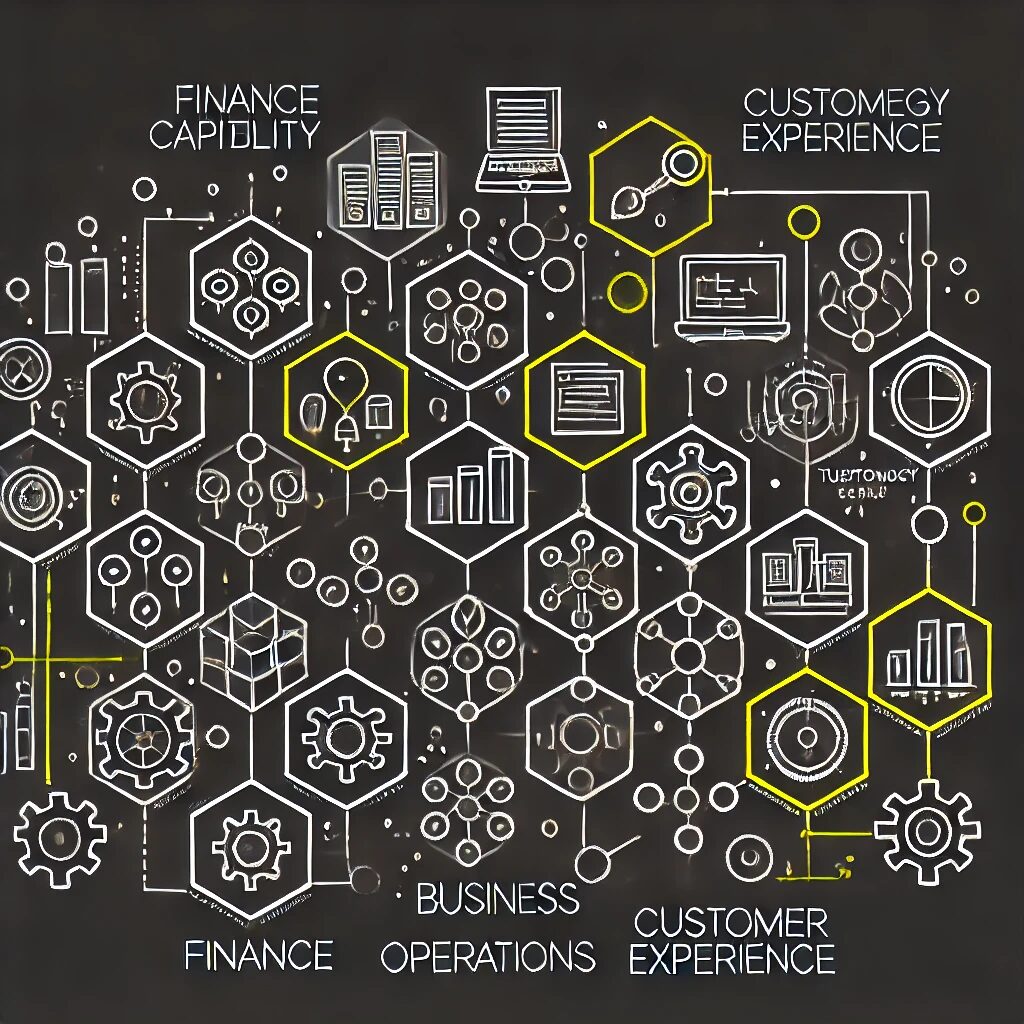
Architecting Chemical Evolution. Transforming Molecules to Digital Masters Through Enterprise Architecture
The chemical manufacturing industry stands at a critical inflection point where digital capabilities rapidly become the defining factor between market leaders and followers. Companies face unprecedented pressure to enhance operational efficiency, accelerate innovation, and build more resilient supply chains while navigating complex regulatory requirements and sustainability imperatives.
Enterprise Architecture (EA) is the essential lynchpin for successful digital transformation in chemical manufacturing, creating the critical bridge between business strategy and technology implementation. EA enables chemical manufacturers to transform complexity into competitive advantage in an increasingly digital world by providing a holistic blueprint that aligns people, processes, information, and technology.
1: The Digital Imperative for Chemical Manufacturers
Chemical companies face mounting pressure to embrace digital transformation as market dynamics, customer expectations, and competitive threats evolve at unprecedented speed. Traditional approaches to operations and innovation are no longer sufficient in this rapidly changing landscape.
- Margin Compression: Intensifying global competition and volatile raw material costs are squeezing margins, requiring digital optimization of operations to maintain profitability and competitiveness.
- Innovation Acceleration: Product development lifecycles continue to shrink, demanding digital tools that accelerate the journey from molecular concept to commercial production.
- Customer Expectations: B2B buyers increasingly expect consumer-grade digital experiences with seamless self-service, real-time visibility, and personalized solutions.
- Supply Chain Volatility: Recent global disruptions have exposed vulnerabilities in traditional supply networks, driving the need for digitally-enabled visibility, agility, and resilience.
- Sustainability Mandates: Growing regulatory and market pressures for environmental performance require digital capabilities to track, optimize, and report on sustainability metrics across the value chain.
2: The Enterprise Architecture Foundation
Enterprise Architecture provides the essential framework that connects business strategy to execution, creating the structural foundation for successful digital transformation in chemical manufacturing.
- Strategic Alignment: EA establishes clear traceability between strategic objectives and technology investments, ensuring digital initiatives deliver tangible business value rather than technology for technology’s sake.
- Holistic Perspective: The comprehensive view spanning business, information, application, and technology domains enables chemical manufacturers to address interdependencies that siloed approaches miss.
- Complexity Management: Systematic documentation and analysis of the enterprise landscape allows chemical companies to tame the complexity that has evolved through decades of operational and technological change.
- Future-State Visioning: EA creates a clear target state architecture that guides transformation decisions and investments toward cohesive outcomes rather than disconnected point solutions.
- Change Navigation: The architectural roadmap bridges current and future states with logical transition architectures, enabling chemical manufacturers to execute transformation while maintaining operational continuity.
3: The Chemical Industry’s Unique Architectural Challenges
Chemical manufacturing presents distinctive enterprise architecture challenges that require specialized approaches beyond generic EA frameworks and methodologies.
- Process-Asset Integration: Chemical companies must architect for tight integration between physical assets (reactors, equipment, instrumentation) and digital systems that monitor and control production processes.
- Complex Value Chains: The multi-tiered nature of chemical value chains—from raw materials through intermediates to finished products—demands architectural patterns that support end-to-end visibility and traceability.
- Regulatory Compliance: Stringent regulatory requirements across safety, environment, and product stewardship necessitate architectural approaches that ensure compliance while controlling associated costs.
- Intellectual Property Protection: Formulations, processes, and other proprietary knowledge require specialized information architecture patterns that balance protection with accessibility for authorized innovation.
- Legacy Operational Technology: Decades-old control systems and manufacturing equipment with extended lifecycles create intricate integration challenges not found in purely digital enterprises.
4: Enterprise Architecture Domains for Chemical Transformation
Successful digital transformation in chemical manufacturing requires integrated architecture across multiple domains that collectively enable cohesive transformation.
- Business Architecture: Maps strategic objectives to operational capabilities, processes, and organizational structures, establishing the business context for digital initiatives in terms meaningful to chemical industry executives.
- Information Architecture: Defines the data assets, models, flows, and governance structures needed to transform chemical manufacturing’s vast data volumes into actionable intelligence for decisions and optimizations.
- Application Architecture: Specifies the software systems, integration patterns, and functionality required to digitalize chemical processes from R&D through manufacturing to customer fulfillment.
- Technology Architecture: Designs the hardware, networks, platforms, and infrastructure needed to support specialized chemical manufacturing applications while ensuring security, performance, and reliability.
- Security Architecture: Establishes the frameworks, controls, and protocols necessary to protect sensitive formulations, process knowledge, and operational systems from increasingly sophisticated cyber threats.
Did You Know
- According to a 2023 McKinsey study, chemical manufacturers with mature Enterprise Architecture practices achieve a 3.2x higher return on digital investments than companies pursuing siloed digital initiatives without architectural guidance.
5: EA-Driven Transformation: Key Focus Areas for Chemical Manufacturers
Enterprise Architecture enables targeted digital transformation across critical value-creating areas in chemical manufacturing operations.
- Operational Excellence: Architecting digital systems that optimize production scheduling, energy utilization, quality control, and asset performance delivers measurable efficiency gains and cost reductions.
- Innovation Acceleration: Designing connected platforms that enhance collaboration, simulation, data analysis, and knowledge management significantly reduces time-to-market for new chemical products.
- Supply Chain Resilience: Creating architectural patterns for end-to-end visibility, scenario planning, and alternative sourcing enhances adaptability to supply disruptions and demand volatility.
- Customer Experience: Developing architectural blueprints for omnichannel engagement, customer portals, and digitized technical service transforms traditional customer relationships into strategic partnerships.
- Sustainability Enhancement: Establishing systems for environmental footprint measurement, circular resource management, and compliance reporting addresses growing sustainability imperatives in chemical markets.
6: The EA Operating Model for Chemical Manufacturers
Establishing an effective Enterprise Architecture practice requires an operating model tailored to chemical manufacturing realities.
- Strategic Positioning: Locating the EA function with appropriate executive sponsorship and cross-functional visibility ensures architecture drives business outcomes rather than becoming a technical exercise.
- Team Composition: Assembling architects with both chemical domain knowledge and digital expertise creates the credibility needed to influence decisions across both operational and IT functions.
- Governance Framework: Establishing clear decision rights, review processes, and compliance mechanisms ensures architectural integrity while maintaining transformation momentum.
- Stakeholder Engagement: Developing systematic approaches to involve operations, R&D, supply chain, and commercial stakeholders ensures architecture addresses real business needs rather than theoretical models.
- Value Measurement: Implementing metrics that track architectural contribution to business outcomes sustains organizational support for EA investment and influence.
7: The Digital Plant Architecture: From Molecules to Megabytes
The manufacturing core presents the most significant digital transformation opportunity for chemical companies, requiring specialized architectural approaches.
- OT-IT Convergence: Creating architectural patterns that bridge operational technology and information technology environments enables data-driven manufacturing while respecting the unique requirements of each domain.
- Edge-to-Cloud Integration: Designing hybrid architectures that process critical control data at the edge while leveraging cloud capabilities for analytics and optimization balances performance with scalability needs.
- Digital Twin Implementation: Establishing the technical foundation for virtual plant models integrating process simulation, asset information, and real-time data enables unprecedented operational insights and scenario testing.
- Advanced Process Control: Architecting next-generation control systems incorporating artificial intelligence and machine learning enhances process stability, yield, and quality beyond traditional control approaches.
- Mobile Enablement: Developing secure frameworks for mobile access to operational data and workflows increases workforce productivity while enhancing safety through better situational awareness.
8: Data Architecture: Turning Chemical Complexity into Digital Insight
Information architecture is particularly crucial for chemical manufacturers dealing with complex molecular, process, and market data across disparate systems.
- Master Data Management: Establishing unified reference data for materials, formulations, equipment, and customers creates the foundation for consistent analysis and reporting across global operations.
- Process Data Integration: Designing data models and integration patterns that combine time-series process data with contextual information enables deeper operational insights and optimization opportunities.
- Analytical Data Platforms: Creating specialized data structures optimized for chemical-specific analytics supports applications from formulation optimization to predictive maintenance.
- Knowledge Management: Architecting systems to capture, organize, and retrieve institutional knowledge about chemical processes, troubleshooting, and best practices addresses critical knowledge retention challenges.
- Data Governance: Implementing governance frameworks that balance accessibility with security ensures valuable intellectual property remains protected while still enabling innovation and improvement.
9: Application Architecture: Building the Chemical Digital Ecosystem
Chemical manufacturers require carefully designed application landscapes that support specialized industry requirements while enabling digital innovation.
- Core System Modernization: Creating strategies to evolve legacy ERP, laboratory, and manufacturing systems enables modern digital capabilities without disrupting critical operations.
- Integration Architecture: Designing flexible integration patterns using APIs, microservices, and data hubs overcomes traditional silos between R&D, manufacturing, supply chain, and commercial systems.
- Digital Workplace: Architecting collaboration platforms, knowledge bases, and workflow tools that connect the workforce enhances productivity and accelerates decision making across global operations.
- Advanced Analytics Ecosystem: Establishing the application foundation for predictive modeling, machine learning, and artificial intelligence enables data-driven optimization across the value chain.
- Ecosystem Connectivity: Developing architectural patterns for secure partner and customer system connections creates the foundation for more collaborative business models and value networks.
Did You Know
- Gartner Research found that chemical companies with established EA capabilities successfully implement 74% of their digital transformation initiatives on time and on budget, compared to just 32% success rates for companies without formalized architecture practices.
10: Technology Architecture: The Digital Foundation for Chemical Innovation
The underlying technology infrastructure must be carefully architected to support chemical manufacturing’s specialized requirements and emerging digital opportunities.
- Industrial IoT Platform: Designing the foundation for connected sensors, equipment, and processes creates the data streams essential for real-time optimization and predictive capabilities.
- Hybrid Cloud Strategy: Creating architectural patterns that appropriately distribute workloads across on-premises, private cloud, and public cloud environments optimizes both performance and cost.
- Edge Computing Framework: Establishing local processing capabilities for time-sensitive data and analytics addresses latency requirements critical for process control and safety systems.
- Connectivity Architecture: Designing specialized network infrastructure supporting everything from high-reliability control systems to mobile field applications ensures appropriate performance for each use case.
- Cybersecurity Infrastructure: Implementing layered security controls that protect both information technology and operational technology systems addresses the expanding threat surface created by digital transformation.
11: EA-Guided Technology Selection and Implementation
Enterprise Architecture provides the crucial foundation for making more effective technology decisions that advance digital transformation goals in chemical manufacturing.
- Solution Evaluation Framework: Establishing architecture-aligned criteria for assessing digital solutions ensures selections fit the target state rather than creating new integration challenges or technical debt.
- Build vs. Buy Guidance: Developing clear decision frameworks for when to purchase commercial solutions versus custom development balances speed, cost, and strategic differentiation needs.
- Implementation Sequencing: Creating logical dependency maps for digital initiatives enables more effective program planning that addresses prerequisites while delivering incremental business value.
- Technology Standardization: Defining preferred technology patterns, platforms, and products reduces complexity and support costs while enhancing integration and knowledge sharing across the enterprise.
- Architecture Review Process: Implementing systematic validation against architectural principles and patterns prevents proliferation of solutions that undermine long-term transformation goals.
12: EA for Chemical Digital Transformation Success Stories
Leading chemical manufacturers have leveraged Enterprise Architecture to drive significant business outcomes through more effective digital transformation execution.
- Manufacturing Optimization: A global specialty chemicals producer used EA-guided IoT implementation to connect 15,000 sensors across 12 plants, achieving 8.7% production efficiency improvement and $43M annual cost reduction.
- Innovation Acceleration: A mid-sized chemicals manufacturer implemented an EA-designed digital R&D platform, reducing new product development cycles by 40% while increasing successful commercialization rates by 25%.
- Supply Chain Transformation: A chemical corporation applied EA methodology to redesign its end-to-end supply network visibility, reducing inventory requirements by 23% while improving service levels to 99.1%.
- Customer Experience Enhancement: An agricultural inputs company followed EA guidance to implement a unified customer engagement platform, increasing digital self-service adoption by 78% and improving Net Promoter Score by 18 points.
- Sustainability Enhancement: A global chemical company leveraged EA to create an integrated sustainability data platform, reducing compliance reporting effort by 65% while enabling more effective carbon reduction targeting.
13: Overcoming Enterprise Architecture Challenges in Chemical Manufacturing
Despite its value, implementing effective EA in chemical manufacturing environments presents significant challenges that must be proactively addressed.
- Cultural Resistance: Overcoming the traditionally conservative, engineering-driven culture of chemical companies requires EA approaches that demonstrate tangible value through practical use cases rather than theoretical models.
- Operational Technology Integration: Bridging the historically separate worlds of plant floor technology and corporate IT demands specialized architectural skills combining industrial control systems knowledge with enterprise integration expertise.
- Technical Debt Management: Addressing decades of accumulated legacy systems and infrastructure requires pragmatic architectural approaches that balance transformation with operational continuity.
- Business Engagement: Building effective partnerships between EA and chemical business units necessitates architects who can translate technical concepts into business impacts using industry-specific language and examples.
- Talent Development: Growing architects with both chemical domain knowledge and digital expertise requires intentional recruitment, training, and career development strategies rarely found in traditional chemical company HR practices.
Did You Know
- A Deloitte industry analysis revealed that chemical manufacturers that prioritize Enterprise Architecture as a transformation enabler achieve EBITDA margins 4.8 percentage points higher than industry peers, primarily through more effective operational digitalization and reduced technology waste.
14: The Future of Chemical Industry Enterprise Architecture
Forward-looking Enterprise Architecture must anticipate emerging trends and technologies that will reshape the competitive landscape for chemical manufacturers.
- Circular Economy Enablement: Developing architectural patterns for material tracking, recycling, and reuse creates the foundation for circular business models increasingly demanded by regulatory and market forces.
- Ecosystem Architecture: Expanding EA scope beyond enterprise boundaries to include partners, customers, and suppliers enables more collaborative value creation in increasingly connected chemical value networks.
- Autonomous Operations: Creating the architectural foundation for self-optimizing plants incorporating artificial intelligence, advanced robotics, and predictive systems prepares for manufacturing’s autonomous future.
- Outcome-Based Models: Architecting systems to support chemical-as-a-service and performance-based offerings rather than traditional product transactions addresses growing customer interest in value-based relationships.
- Sustainability by Design: Integrating environmental impact analysis, carbon tracking, and regulatory compliance directly into core business and operational systems transforms sustainability from reporting exercise to operational imperative.
Takeaway
Enterprise Architecture is the indispensable lynchpin for digital transformation in chemical manufacturing, providing the structural integrity needed to translate strategic aspirations into operational reality. By creating a blueprint that aligns business capabilities, information assets, application systems, and technology infrastructure, EA enables chemical companies to navigate the complexity of digital transformation while maintaining operational continuity. This architectural foundation transforms potentially disconnected digital initiatives into a cohesive program that delivers measurable business value across manufacturing operations, supply chains, innovation processes, and customer experiences. EA provides the essential framework for converting digital potential into competitive advantage in an industry characterized by asset intensity, process complexity, and safety criticality.
Next Steps
- Conduct an Architectural Maturity Assessment: Evaluate your organization’s current EA capabilities and practices against chemical industry benchmarks to identify improvement opportunities and priority focus areas.
- Develop a Digital Reference Architecture: Create a chemical-specific target state architecture model that illustrates how business, information, application, and technology elements will work together to enable your digital transformation vision.
- Establish an EA Governance Framework: Define the decision processes, review checkpoints, and compliance mechanisms that will ensure technology decisions align with architectural direction and business priorities.
- Build Cross-Functional Engagement: Conduct workshops with key stakeholders across operations, R&D, supply chain, and commercial functions to validate architectural models and build organizational buy-in.
- Create an Architectural Roadmap: Develop a sequenced implementation plan that balances quick wins with long-term strategic initiatives, identifying key dependencies and transition architectures needed for successful transformation.



